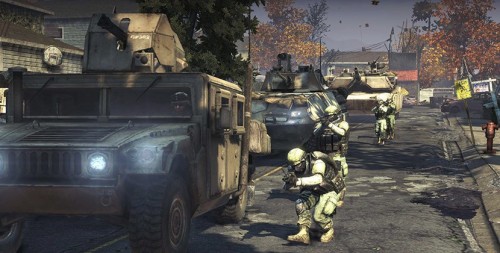THQ’s much-publicised first-person shooter Homefront launched last week just as the United States and its allies were preparing an assault on Colonel Gaddafi’s troops in Libya, flexing its muscles as the world’s sole superpower.
It’s ironic because in Homefront, a powerful North Korea invades the US in 2027 after several crises – sky-high oil prices, a deadly flu, and the crumbling dollar – had devastated the once-great nation. Not too ironic because it would take a really dramatic fall in just 16 years for this to happen, as we saw how US-led forces decimated Gaddafi’s troops this week.
Why am I bringing this up? That’s because the story in Homefront forms a good part of the game. For many US gamers, it strikes home the fear of invasion, as seen previously in movies such as Red Dawn, and games such as World in Conflict and Call of Duty: Modern Warfare 2.
Where Homefront succeeds is in portraying this fight in the US home soil in even more harrowing ways. You are introduced at the start of the game to summary executions, concentration camps and other general abuses by the North Korean invaders, who are so easy to hate you won’t think twice about firing on them.
Through NPCs (non-playing characters), you’ll find that not everyone is supportive of the resistance, of which you play a part in the game. Some just want to be left alone, so their Korean masters do not bring any more pain on them than at the concentration camps the invaders have set up.
The single player campaign is rather short. In the Xbox version, you could take only five hours, maybe a little more, to complete the campaign, though Homefront does have its moments.
The crane-like automatic sentry gun, which pumps deadly lead in your face, is reminiscent of the enemy contraptions in Half Life, which you must find ways to get around and destroy. At the same time, an armoured buggy – called Goliath – can be remote controlled by you to fire on encroaching enemies. It’s not as cool, or realistic, as MW2’s Predator drone strikes, but it’s a break from the regular cover-and-fire routine.
There are some great fight scenes as well. Early on, there is a pretty gruesome one where a rebel assault on a North Korean facility goes wrong and explosives are accidentally fired on friendly forces, many of whom burn badly as you run past them to your objective.
Unfortunately, too many of the other levels are spent running around the backyards of suburban America, hopping over fences from one fight to another, hiding behind cover, firing on an enemy and slowly advancing on each objective. This just feels very regular FPS, not like what we saw in MW2, which included many large-scale engagements.
What developer Kaos Studios could also have improved on are the characters who accompany you – rather blandly – throughout your missions.
Throughout the game, you follow Connor, is a trigger-happy “motherf**ker” spewing toughie who just wants revenge on the invaders. Your other partner Rianna is a one-dimensional foil to him, in that she “thinks” and “feels” more about why the crew is carrying out mission after mission, but goes ahead and fires away anyway. Both are flat characters, quite unlike what you get in the seminal Half Life, for example.
Plus, some of the grittiness in the storyline is spoiled by rather unbelievable missions. In many of them, three of you – your crew don’t get killed, by the way – are sent in to “infiltrate” a concentration camp but end up wiping out an entire Korean battalion. Seriously, if three guys can stack up a body count of hundreds, why would the US even be occupied?
On the plus side, Homefront’s multiplayer mode comes with some interesting elements. Besides just getting on kill streaks and knifing people to get badges, it also requires you to do other tasks, such as fly a drone long enough in order to call in a deadly strike on the enemy. It’s a slight variation to the usual trigger-happy multiplayer shoot fest online these days.
On the whole, I’d say Homefront is an above-average game set in a compelling but increasingly-common scene – heartland America. It has a great story, but that should have been beefed up by more compelling gameplay that is large-scale and believable, rather than the old and tested one (or three) men against a hundred in missions that can feel repetitive.
Is the game worth a try? I’d say okay, if you have the moolah and time to do so while you play Crysis 2, the much-awaited sequel to one of the best PC shooters in years that is shipping as I write. I, for one, am switching to Crysis mode once I get my hands on the game.





